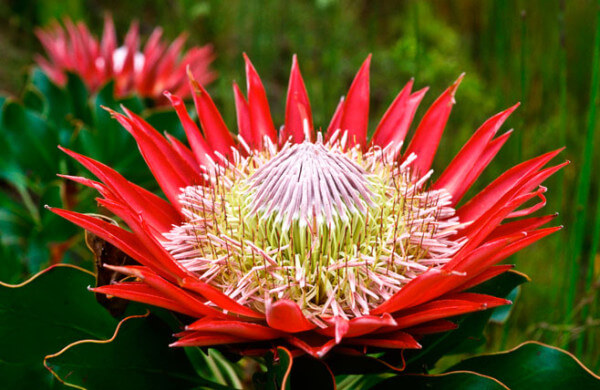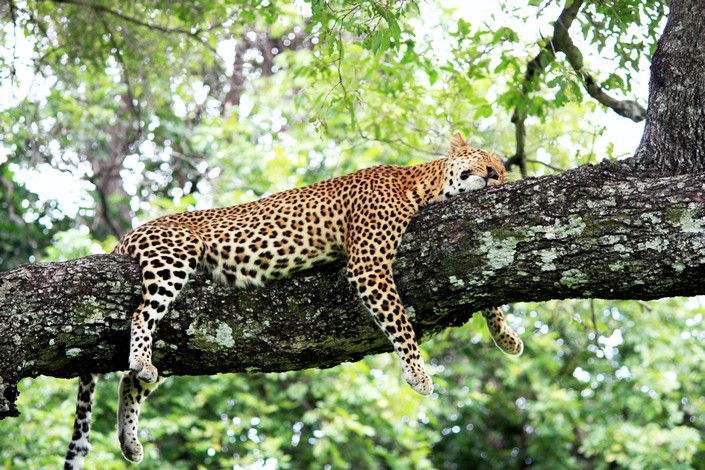Countries have national symbols to show the world that it is a national community. National symbols are used to unite people by using pictorial representations such as animals and flowers to reflect the country’s values, goals, or history. You will often see them used in sport’s events or other patriotic celebrations. Below are South Africa’s National Symbols.
South Africa’s National Animal
The animal chosen to represent South Africa is the Springbok. In fact the South African rugby team is called the ‘Springboks’, locally known as ‘the bokke’. The Springbok (Antidorcas marsupialis) gets its common name from the way it jumps and springs around. It is extremely fast and reaches speeds of 100km/hour and leaps as high as 4 metres. When a male Springbok wants to show off its strength to attract a mate, or to ward off predators, he trots with his legs stiff off the ground and jumps high into the air and arches his back – a very amusing display to see!
Springboks live in dry, barren areas and open grass plains, such as the Free State, North West and Karoo. It is often that you will see a Springbok on an African safari, and hopefully you can see them springing around and ‘strutting their stuff’!
The Springbok (Image)
South Africa’s National Bird
The Blue Crane (Anthropoides paradisia) has been chosen for this title, probably due to the fact that they reside almost entirely to the country. They are about a metre tall and a beautiful shade of light blue-grey, with a long neck and a rather large head. Their legs are long and spindly with elegant wing plumes which sweep along the ground. They are very graceful birds. You will find them in the Karoo, the grasslands of KwaZulu-Natal and the Highveld. Occasionally you will hear a distinctive high-pitched and rattling croak which can be heard from some distance, the call of the Blue Crane.
The Blue Crane (Image)
South Africa’s National Flower
The beautiful and wild-growing King Protea (Protea cynaroides) takes this honour. It has a very large flower head with large petals and can be seen in a variety of colours. The King Protea is the largest of the Proteas. It is distributed in the south-western and southern areas of the Western Cape. South Africa’s national cricket team are called ‘The Proteas’.
The King Protea (Image)
South Africa’s National Fish
Yes, there is even a national fish – the Galjoen (Dichistius capensis). The Galjoen was chosen as the country’s national fish because it is only found along the coast from Namibia to Durban, and nowhere else in the world. The Galjoen changes colour, depending on where it is swimming. Near rocks it is almost completely black, while in sandy areas the colour changes to silver-bronze. Anglers love to catch this fish and it known as a game fighter.
The Galjoen (Image)
South Africa’s National Tree
Last, but not least is South Africa’s National Tree – the Yellowwood tree. The Yellowwood family has been growing in this part of Africa for over 100- million years. The real Yellowwood (Podocarpus latifolius), South Africa’s national tree, is found on Table Mountain, along the southern and eastern Cape coast, and in the valleys of the Drakensberg up to Soutpansberg and Blouberg in Limpopo.
These trees can grow up to 40m in height with the base of the trunk being about 3m in diameter. The Yellowwood tree is a protected species. The bark of the Yellowwood is khaki-coloured and almost grey when it is old, and the bark peels off in strips. The Yellowwood is one of South Africa’s most valuable timber trees.
The Yellowwood Tree (Image)
South African tours:
-
Tour Length 22 days Group Size Min 1 Max 22 Starts & Ends Starts: Johannesburg Ends: Cape Town Countries South Africa, Lesotho, Eswatini (Formerly Swaziland) Overview Set out on an exciting journey across some of southern Africa's most breathtaking landscapes. Take the breathtaking coastline road from Johannesburg to Cape Town in 22 days, stopping at many amazing locations along the way. Take game drives in the Kruger National Park to locate elusive animals, unwind on beautiful beaches, interact with the Xhosa people in Cintsa, and mix things up with two exciting nights in Cape Town. See the best of southern Africa's blessed natural beauty, accompanied by a local guide who can offer you all the best advice and a group of eager to discover adventurers. From the savanna of Kruger to the lush wetlands of the St Lucia Estuary to the dramatic ocean vistas and fertile vineyards along the Wild Coast.
View Tour Check Availability22 Day Southern Africa Overland Tour
Tour start → end dates Price Enquire 15 Jun 2024 → 06 Jul 2024 From
R53760Check Availability 20 Jul 2024 → 10 Aug 2024 From
R59220Check Availability 10 Aug 2024 → 31 Aug 2024 From
R58065Check Availability 07 Sep 2024 → 28 Sep 2024 From
R58640Check Availability 21 Sep 2024 → 12 Oct 2024 From
R58065Check Availability 05 Oct 2024 → 26 Oct 2024 From
R58065Check Availability 16 Nov 2024 → 07 Dec 2024 From
R55915Check Availability 07 Dec 2024 → 28 Dec 2024 From
R55915Check Availability 21 Dec 2024 → 11 Jan 2025 From
R55915Check Availability 04 Jan 2025 → 25 Jan 2025 From
R57505Check Availability 18 Jan 2025 → 08 Feb 2025 From
R57505Check Availability 15 Feb 2025 → 08 Mar 2025 From
R57505Check Availability 15 Mar 2025 → 05 Apr 2025 From
R57505Check Availability 12 Apr 2025 → 03 May 2025 From
R59805Check Availability 17 May 2025 → 07 Jun 2025 From
R59805Check Availability 14 Jun 2025 → 05 Jul 2025 From
R59805Check Availability 05 Jul 2025 → 26 Jul 2025 From
R59805Check Availability 19 Jul 2025 → 09 Aug 2025 From
R62110Check Availability 09 Aug 2025 → 30 Aug 2025 From
R62110Check Availability 23 Aug 2025 → 13 Sep 2025 From
R62110Check Availability 06 Sep 2025 → 27 Sep 2025 From
R62110Check Availability 20 Sep 2025 → 11 Oct 2025 From
R62110Check Availability 11 Oct 2025 → 01 Nov 2025 From
R59805Check Availability 08 Nov 2025 → 29 Nov 2025 From
R59805Check Availability 29 Nov 2025 → 20 Dec 2025 From
R57505Check Availability 20 Dec 2025 → 10 Jan 2026 From
R57505Check Availability -
Tour Length 16 days Group Size Min 1 Max 16 Starts & Ends Starts: Johannesburg Ends: Johannesburg Countries Zimbabwe, Botswana, South Africa Overview Travel to Southern Africa and return to South Africa via Johannesburg, the Kruger National Park, Victoria Falls, and the Khama Rhino Sanctuary. This is your chance to see gorgeous sunsets, go on safari over the plains of Africa, camp in a secluded area, and travel through rivers teeming with recognizable species. Experience the wonders of majestic waterfalls, be mesmerized by sightings of threatened species, and be encouraged by the perseverance of communities rising out of difficult circumstances as you travel through South Africa, Botswana, and Zimbabwe. Take in Southern Africa and leave with a heart full of memories, inspiration, and fresh hope. View Tour Check Availability16 Day Southern Africa Overland
Tour start → end dates Price Enquire 02 Jun 2024 → 17 Jun 2024 From
R81385Check Availability 07 Jul 2024 → 22 Jul 2024 From
R83700Check Availability 21 Jul 2024 → 05 Aug 2024 From
R82070Check Availability 04 Aug 2024 → 19 Aug 2024 From
R88600Check Availability 18 Aug 2024 → 02 Sep 2024 From
R84520Check Availability 15 Sep 2024 → 30 Sep 2024 From
R88600Check Availability 22 Sep 2024 → 07 Oct 2024 From
R86890Check Availability 06 Oct 2024 → 21 Oct 2024 From
R88465Check Availability 20 Oct 2024 → 04 Nov 2024 From
R82960Check Availability 17 Nov 2024 → 02 Dec 2024 From
R75990Check Availability 08 Dec 2024 → 23 Dec 2024 From
R75990Check Availability 22 Dec 2024 → 06 Jan 2025 From
R75990Check Availability 12 Jan 2025 → 27 Jan 2025 From
R81280Check Availability 09 Feb 2025 → 24 Feb 2025 From
R81280Check Availability 09 Mar 2025 → 24 Mar 2025 From
R81280Check Availability 06 Apr 2025 → 21 Apr 2025 From
R81280Check Availability 27 Apr 2025 → 12 May 2025 From
R81280Check Availability 18 May 2025 → 02 Jun 2025 From
R81280Check Availability 01 Jun 2025 → 16 Jun 2025 From
R84530Check Availability 15 Jun 2025 → 30 Jun 2025 From
R84530Check Availability 29 Jun 2025 → 14 Jul 2025 From
R87785Check Availability 06 Jul 2025 → 21 Jul 2025 From
R87785Check Availability 13 Jul 2025 → 28 Jul 2025 From
R87785Check Availability 27 Jul 2025 → 11 Aug 2025 From
R87785Check Availability 10 Aug 2025 → 25 Aug 2025 From
R87785Check Availability 24 Aug 2025 → 08 Sep 2025 From
R87785Check Availability 31 Aug 2025 → 15 Sep 2025 From
R87785Check Availability 07 Sep 2025 → 22 Sep 2025 From
R84530Check Availability 14 Sep 2025 → 29 Sep 2025 From
R84530Check Availability 21 Sep 2025 → 06 Oct 2025 From
R84530Check Availability 28 Sep 2025 → 13 Oct 2025 From
R84530Check Availability 05 Oct 2025 → 20 Oct 2025 From
R84530Check Availability 19 Oct 2025 → 03 Nov 2025 From
R81280Check Availability 02 Nov 2025 → 17 Nov 2025 From
R81280Check Availability 21 Dec 2025 → 05 Jan 2026 From
R84530Check Availability 26 Apr 2024 → 01 Jan 1970 From
R75990Check Availability -
Tour Length 14 days Group Size Min 2 Max 10 Starts & Ends Starts: Cape Town Ends: Port Elizabeth Countries South Africa Overview In the south of South Africa, there is a great deal of diversity and colour. Cape Town, for example, is a world-class city that will enchant any visitor. With its picturesque wine farms and charming towns, the Winelands entices visitors to stay and spend time there, while the Whale Coast draws visitors hoping to see the giants of the ocean in season. Beautiful lagoons, sandy beaches, impressive cliffs, and lush vegetation characterise the Garden Route. South Africa's wildlife can be encountered at Addo Elephant Park. Join us on a journey of discovery as we explore this magical region with a small group of travelWe will not only show you the well-known highlights but also hidden gems - we will share our favourite destinations with you, as well as our passion for the country. View Tour Check Availability14 Day South Africa Experience – Small Group Tour
Tour start → end dates Price Enquire 26 Sep 2024 → 09 Oct 2024 From
R49000Check Availability 10 Oct 2024 → 23 Oct 2024 From
R49000Check Availability 07 Nov 2024 → 20 Nov 2024 From
R49000Check Availability 05 Dec 2024 → 18 Dec 2024 From
R49000Check Availability
These national symbols are not mere static emblems; they are vibrant expressions of the South African spirit, woven into the tapestry of the nation’s identity. Let them inspire you to uncover the magic of this captivating land, where adventure awaits at every turn.













0 Comments